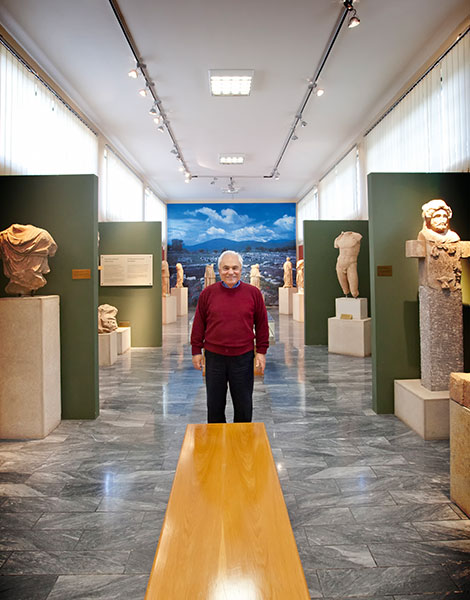Veteran archaeologist Petros Themelis talks passionately about the Sanctuary of Isis and Serapis, the new excavation site next to the ancient theater, which was mentioned in the writings of 2nd century AD Greek traveler and geographer Pausanias. Themelis describes the colossal structure that dates back to Roman times –the adoration of Isis began to spread in Greece after 146 BC – with its roughly ten halls and large underground stoa, where a number of fragments of marble sculptures have been found. What has impressed archaeologists so far is not only the size of the halls, some of which exceed a height of 5m and have arched ceilings, but also the elaborate mosaic floors.
More than 36 years have passed since Themelis first came to Ancient Messene. Then, he was faced with a neglected archaeological site with very few finds but with a lot of potential. Over the years, his commitment to the ancient city of Messene, a city that flourished from the 4th century BC to the 4th century AD, never waned. Thanks to his zeal and methodical work, Themelis and his team have uncovered many monuments – which have been carefully restored – that, together with the approximately 18,000 portable finds, make up the archaeological park of Ancient Messene. The entire site covers an area of 40 hectares.

© Giannis Giannelos

© Perikles Merakos
The past
Ancient Messene was founded in 369 BC by Theban general Epaminondas when he called upon the Messenians of the diaspora to return to their homeland. The Messenians had been driven out by the Spartans following their defeat in the Messenian Wars of the 8th and 7th centuries BC, and found refuge in Nafpaktos and later in Sicily. Epaminondas chose Messene due to the natural fortification that its location – at the foothills of Mount Ithome – offered. Ancient Messene went on to become an important cultural center of antiquity and continued to be a principal political and cultural center following Greece’s fall to the Romans in 146 BC.
With a view to the south and the Messenian Gulf and with its back protected to the north, the location of Ancient Messene was indeed strategic. Located south of the town of Mavrommati, the ancient city is striking with its unblemished landscape that stretches across the countryside. Walking around the ruins you can still feel a human presence. This feeling is reinforced with the restoration of the monuments and the creation of footpaths that lead visitors to the funerary monuments, the sanctuaries, the theater, the Agora, the Asklepieion, the Gymnasium, and the Stadium.

© Angelos Giotopoulos
The restoration and conservation works have not stopped all these years, but they are laborious and costly. At the Sanctuary of Isis, the workers and cranes work continuously. The stages of excavation and restoration include removing soil, conserving finds, maintaining the excavated areas, and arranging public access to monuments. The excavation works require a lot of time and effort because workers have to use ladders to descend to the Sanctuary, which is located underground, and use sacks to remove the soil that covers everything.
The monuments were left to their fate following the city’s abandonment at the end of the 4th century AD. The big difference, however, between Ancient Messene and most other cities of Greek antiquity is that, despite the fact that it was destroyed, a modern settlement was not built on its ruins. Regarding the cost of the excavation and restoration works, Themelis is forthright: “In Greece, the State has to be more concerned with culture, and sites like Ancient Messene should be better cared for by the Ministry of Culture. Our work is supported by private individuals, but unfortunately it’s not enough. For the past five to six years since the institutional framework was changed, we haven’t received any government funding for our work, only private funding.”

© Milos Bicanski/Getty Images/Ideal Image
The future
A very important aspect of Themelis’ work in Ancient Messene has to do with creating the best possible interactive experience for the public. He places particular emphasis on the functional use of the archeological park’s ancient monuments. “The dilemma of ‘protection or use of the monuments’ is fallacious, there is no conflict of values. Today, Ancient Messene embraces the concept of displaying modern cultural works.
The socialization of the monuments, the promotion of modern art and the coexistence of ancient and modern works of art are important steps forward. We want Ancient Messene to be a landmark, a place of interest where cultural productions, including dances, conferences and other cultural events, will be held every year. We want the archaeological park to be an area where contemporary Greek artists can perform or exhibit their work.”

© Angelos Giotopoulos
This initiative began in earnest in 2009, when the newly restored Stadium was inaugurated with a concert by Marios Frangoulis that attracted thousands of spectators. Since then, every summer, dozens of festivals, concerts and exhibitions are held in Ancient Messene. The busiest month is July, but cultural events are also organized in June, August and September.
For 2023, the program includes a musical event that is being organized under the auspices of the Megaron Athens Concert Hall and will feature an opera with the participation of a German orchestra, a student theatrical festival with the participation of thousands of children from all over Greece and abroad, and an exhibit of Italian painter and sculptor Franco Murer with twelve paintings of mythological figures that will be printed on canvases and hung at various points of the archaeological park. Moreover, the Small Theater, which is part of the Asklepieion and is located on its western side, has been fully restored. Following the restoration of its upper cavea (seating section), the Small Theater is ready to welcome up to 1,000 spectators.
The information contained in this article was derived, among other resources, from the literary work “Aeneas: Ancient Messene,” published by Diazoma, with a generous donation by the Captain Vassilis and Carmen Constantakopoulos Foundation.












